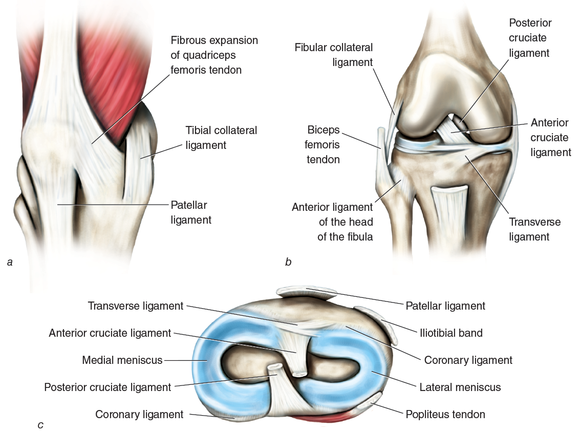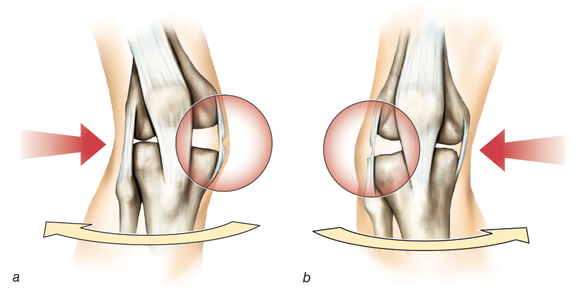Many ligaments make up knee's structure
This is an excerpt from Kinetic Anatomy w/Web Resource-3rd Edition by Robert Behnke.
Like all synovial joints, the knee joint has a capsular ligament. This capsular ligament is unlike others because it consists of portions of other ligaments and fibrous expansions of other structures that cross the knee joint and become part of the capsule (figures 12.10 and 12.11). The components of the capsule include portions of the medial and lateral collateral ligaments and fibrous expansions of the quadriceps femoris, the iliotibial band, the vastus muscles, the sartorius muscle, and the semimembranosus muscle. Probably the best illustration of the pure capsular ligament is seen at the posterior (popliteal space) of the knee joint.
The medial collateral ligament (MCL) and lateral collateral ligament (LCL) of the knee provide stability to either side of the joint, essentially preventing abduction and adduction of the joint and making it a uniaxial joint that flexes and extends in the sagittal plane. The medial collateral ligament runs from the medial condyle of the femur to the medial condyle of the tibia, with some deep fibers attaching to the medial meniscus (discussed later in this chapter). The lateral collateral ligament runs from the lateral condyle of the femur to the head of the fibula. Note that the lateral collateral ligament, unlike the medial collateral ligament, does not have fibers attaching to the lateral meniscus.


Hands On
As you sit in a chair, place the ankle of one leg on top of the other leg's knee joint. Palpate the lateral condyles of both the femur and tibia of the leg crossed on top of the other leg. Find the joint space between the condyles. Move your finger anterior and posterior through the joint line until you feel a cordlike structure. This structure is the lateral collateral ligament. Now consider the role of the medial and lateral collateral ligaments in the mechanics of the knee. Remember that the knee normally only flexes and extends. What ligament would come under stress if a force was applied to the lateral side of the knee joint (often referred to as a valgus force), forcing the joint into abduction (i.e., increasing the space between the tibia and the femur on the medial side of the joint)? (See figure 12.12a for the answer.) What ligament would come under stress if a force was applied to the medial side of the knee joint (a varus force), forcing the joint into adduction (increasing the space between the tibia and the femur on the lateral side of the joint)? (See figure 12.12b.) These stresses placed on the MCL and LCL ligaments are commonly the mechanism of sprains of the knee joint.

In the middle of the knee joint are two ligaments known as the anterior cruciate ligament (ACL) and the posterior cruciate ligament (PCL) (see figures 12.10 and 12.11). The term cruciate means “cross,” and these two ligaments actually cross each other as they pass through the middle of the knee joint. The anterior cruciate ligament runs from just anterior to the intercondylar eminence of the tibia to the posterior medial surface of the lateral condyle of the femur. The primary function of the anterior cruciate ligament is to prevent anterior displacement of the tibia off the distal end of the femur. This ligament, along with the resistance of the posterior muscles crossing the knee joint, prevents the normal knee from hyperextending. The posterior cruciate ligament runs from just posterior to the intercondylar eminence of the tibia to the anterior portion of the medial surface of the medial condyle of the femur. The primary function of the posterior cruciate ligament is to prevent posterior displacement of the tibia off the distal end of the femur. Excessive squatting may place the knee joint into such a degree of flexion that this ligament comes under stress.
Three ligaments of the knee joint are found exclusively on the posterior aspect of the joint: the oblique popliteal ligament, the arcuate ligament, and the ligament of Wrisberg (figure 12.13). The oblique popliteal ligament runs from the posterior aspect of the lateral condyle of the femur to the posterior edge of the medial condyle of the tibia. The arcuate ligament runs from the posterior aspect of the lateral condyle of the femur to the posterior surface of the capsular ligament. The ligament of Wrisberg runs between the posterior horn of the lateral meniscus (see the section on menisci later in this chapter) and the posterior aspect of the medial condyle of the femur.

On the anterior side of the knee, running between the apex of the patella and the tibial tuberosity, is the patellar ligament (figures 12.10 and 12.14). Because the patella is embedded in the patellar tendon, some anatomists consider this structure to be an extension of the quadriceps femoris tendon of insertion. Others, however, label this structure the patellar ligament because it ties bone to bone (patella to tibia). In this text, the structure is known as the patellar ligament. Even though some anatomists hold that the quadriceps tendon inserts on the tibial tuberosity, the simple approach is that the quadriceps muscles attach to the patella and the patella attaches to the tibial tuberosity via the patellar ligament.

Two additional ligaments of the knee joint are unique in that they do not tie bone to bone, the normal function of ligaments. The coronary ligament, actually a portion of the capsular ligament, is responsible for connecting the outer edges of the menisci (see the next section) to the proximal end of the tibia (see figure 12.10). The transverse ligament runs between the anterior horns of the medial and lateral menisci (figure 12.14). This ligament prevents the anterior horn of each meniscus from moving forward when the knee joint moves into extension and the condylar surfaces of both the femur and the tibia exert pressure on the menisci.

Read more about Kinetic Anatomy, Third Edition With Web Resource.
More Excerpts From Kinetic Anatomy w/Web Resource 3rd Edition

Get the latest insights with regular newsletters, plus periodic product information and special insider offers.
JOIN NOW


